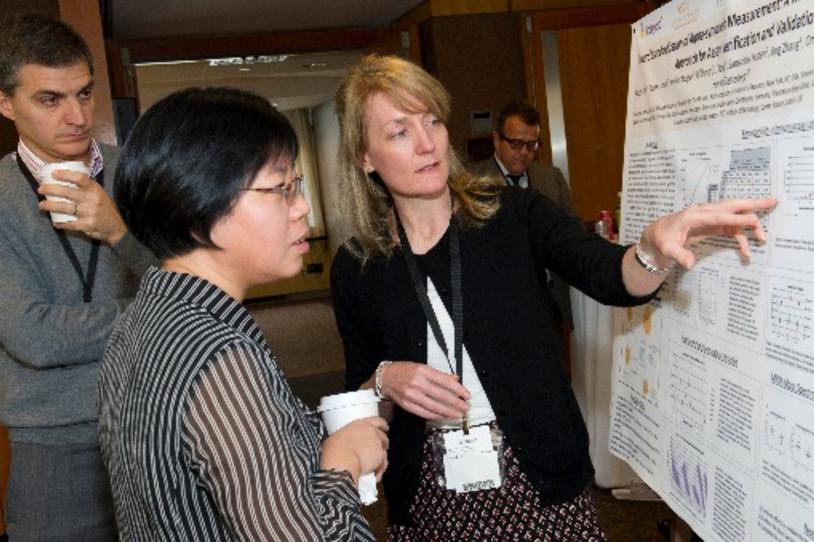
The Michael J. Fox Foundation’s ninth annual scientific meeting — The Parkinson’s Disease Therapeutics Conference — took place on November 3 in New York City. Nearly 300 scientists and business professionals came together to hear the latest in Parkinson’s disease (PD) research. Here are a few of the exciting updates that were shared.
Disease-Modifying Therapies
The topic of glial derived neurotrophic factor (GDNF) — a protein that may prevent the loss of dopamine cells (and even regenerate those that are lost) — was first on the agenda. GDNF can’t be taken orally, so cells that continuously produce GDNF need to be implanted into the area of the brain where most dopamine cells are missing in Parkinson’s. Lars Wahlberg, MD, PhD, of biotech NsGene, Inc., explained how encapsulated cell therapy might make this possible. A Phase Ib safety study is planned for 2016.
LRRK2 kinase inhibitors — drugs that work against the LRRK2 genetic mutation that causes Parkinson’s in some — were next. MJFF’s Marco Baptista, PhD, discussed that these medications might help everyone with PD, not just those with the mutation. He shared the results of an MJFF-led consortium of three competing drug makers who cooperated (pooling their data and compounds) to determine that mild lung changes seen in pre-clinical testing did not cause breathing problems and were reversible. “There is a path forward for LRRK2 kinase inhibitors and this consortium is a collaborative model we can use to move ahead across Parkinson’s research,” said Dr. Baptista.
Symptomatic Treatments
Talk of symptomatic therapies was on optogenetics — combining light (“optics”) and genetics to treat Parkinson’s motor symptoms. Christopher Moore, PhD, Brown University, reminded us how cells communicate with each other — through electrical signals created by the opening and closing of ion (calcium, sodium, etc.) channels. Optogenetics allows scientists to place a light-sensitive channel inside nerve cells and then open or close that channel with light. Optogenetics is currently being studied in pre-clinical models and shows potential for lessening motor symptoms.
Research Tools
The presentation on research tools focused on finding imaging biomarkers (disease indicators) for cognitive (memory and thinking) problems in Parkinson’s. Kathleen Poston, MD, MS, Stanford University, spoke about how today’s clinical trials call for multiple tests (which can be costly and time-consuming) to look for patterns of cognitive problems. She and her colleagues wanted to see if a single test — a “resting state functional MRI,” which examines the brain while a person is relaxed — could replace all of them and accurately diagnose cognitive difficulties in PD. Their study results are currently being analyzed.
Parkinson’s Progression Markers Initiative “Super Session”
Five years into The Parkinson’s Progression Markers Initiative (PPMI) — MJFF’s landmark observational study to find PD biomarkers — the Principal Investigator, Ken Marek, MD, gave an update on how the number and types of participants has expanded, and the categories of valuable data these volunteers are contributing. Researchers reviewed what they’ve concluded thus far from PPMI imaging and genetics information. John Seibyl, MD, The Institute for Neurodegenerative Disorders, talked about why measuring PD with a brain scan is hard — the disease course is slow and variable — and why imaging might therefore not be the only biomarker for Parkinson’s. Andrew Singleton, PhD, agreed, saying, “We’re having a maturing view of Parkinson’s disease that it’s more than one disease, so we may need more than one biomarker to track it.” Dr. Singleton went on to discuss how analysis of PPMI data led to the identification of five potential predictive factors for PD — smell loss, age, gender, family history of PD and a genetic risk score.
Dr. Marek finished by telling the researcher attendees that all of the PPMI data is available to them —we hope they’ll take advantage of it to help us move closer to a biomarker and nearer to a cure.
Hot Topics in Parkinson’s Disease Research
Novel ways to deliver levodopa and innovative methods of tracking symptoms and disease progression rounded out the day. C. Warren Olanow, MD, Mount Sinai, brought us up to speed on dyskinesias (abnormal involuntary movements) and how continuous levodopa delivery might prevent them. He discussed Rytary and Duopa — the latest levodopa preparations to reach market in early 2015 — and then delved into formulations in development — the Accordion pill (designed to slowly release levodopa from the stomach) and continuous under the skin and oral administrations. The first two are in Phase III studies; the oral therapy is in Phase II trials.
Ray Dorsey, MD, MBA, University of Rochester, wrapped up with a potential research tool most of us have in our pockets — the smartphone. He spoke about how smartphone sensors could monitor PD symptoms and disease course, detect treatment response (as in measuring an improvement in balance after medication is administered), even differentiate people who have PD from those who don’t. He also discussed how smartphone apps that log symptoms (voice, dexterity and balance changes) could help find a biomarker, change the way research is done (reach more volunteers and decrease costs and time of clinical trials) and improve care for people with Parkinson’s disease.
It was a full day and a whirlwind tour of the latest research! We left, though, with a renewed energy and excitement about the progress that’s been made and what we hope to accomplish for people with Parkinson’s.
